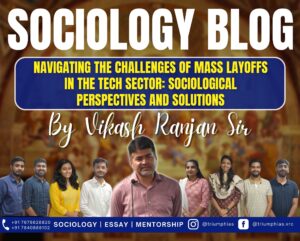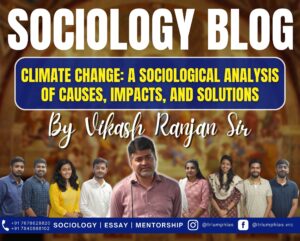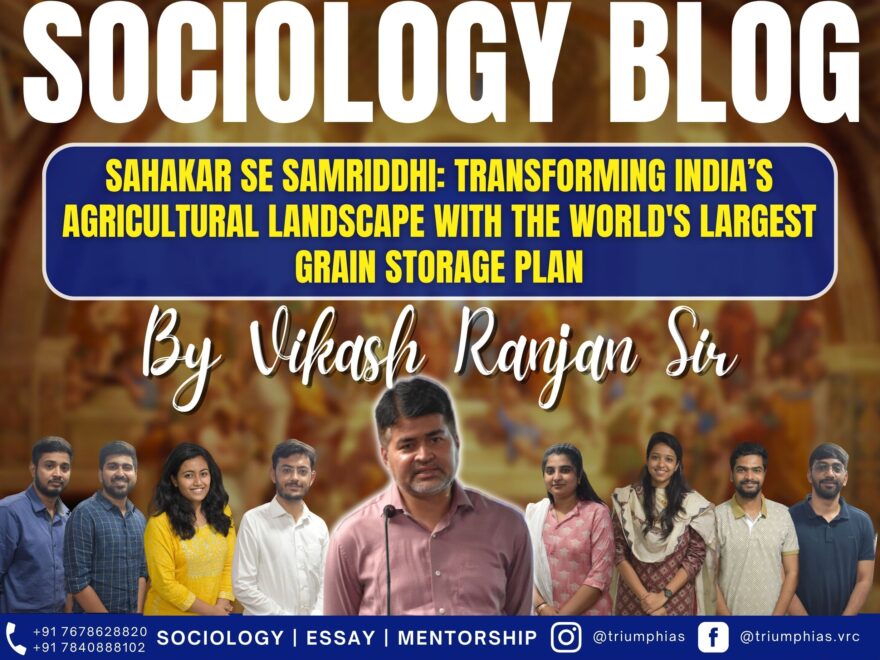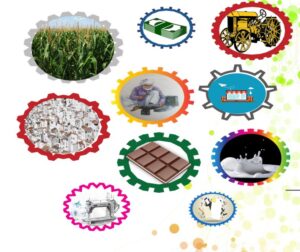‘Sahakar Se Samriddhi’: World’s Largest Grain Storage Program
(Relevant for Sociology Optional for Civil Services Examination)
Paper 2: Rural and Agrarian Transformation: Cooperatives

Context
A new Ministry of Cooperation was formed with a mandate to realize the vision of ‘Sahakar Se Samriddhi’ Union Cabinet has given its approval for the establishment of the “world’s largest grain storage plan in the cooperative sector” with an outlay of around Rs 1 lakh crore.
Sociological Analysis
Positive aspects
Issue with earlier programmes
|
- About the World’s Largest Grain Storage Plan: The “World’s Largest Grain Storage Plan in the Cooperative Sector” aims to expand India’s grain storage capacity from 145 million tonnes to 215 million tonnes.
- Unlike centralized storage systems in other countries, India’s plan focuses on decentralized storage facilities in every block, ranging from 500 to 2000 tonnes. It emphasizes climate-resilient storage solutions and features inter-ministerial coordination to ensure effective implementation.
Rationale and Need for the Plan:
- Curbing post-harvest losses caused by pest attacks and weather.
- Strengthening food security by securely storing a larger portion of grain production.
- Supporting farmers through better prices, reducing distress sales.
- Economizing by lowering transportation costs.
- Boosting employment in rural areas by generating local job opportunities.
Salient Features and Distinctions:
- Scale: The project dwarfs similar endeavors globally, envisioning a massive increase in storage capacity.
- Decentralization: India’s approach deviates from centralized models, aiming for storage facilities in every block.
- Climate Resilience: The plan prioritizes resilient storage facilities, a unique focus amidst global efforts.
- Inter-Ministerial Coordination: A seamless approach involving multiple ministries ensures effective oversight.
- Significant Financial Commitment: An allocation of INR 1 lakh crore showcases unparalleled dedication to the initiative.
Benefits of the Plan:
- Prevention of Food Wastage: Enhanced storage capacity curtails post-harvest losses due to pests and weather.
- Enhanced Food Security: The plan ensures secure storage, bolstering food security for millions.
- Support to Farmers: Improved prices and reduced distress sales empower farmers.
- Cost Savings: Local storage minimizes transportation costs.
- Employment Generation: The plan stimulates rural economies through job creation.
- Strengthening PACS: Primary Agricultural Credit Societies diversify activities, boosting incomes.
- Climate Change Resilience: Robust storage facilities assist in managing climate-induced yield fluctuations.
Challenges and Hurdles:
- PACS Revival: Non-functional PACS pose a challenge and need revival for successful implementation.
- Fair Implementation: Tailoring the plan to diverse regions poses implementation challenges.
- Financing and Convergence: Coordinating various schemes from different ministries requires careful planning.
- Infrastructure and Technology: Implementing advanced storage solutions in rural areas demands technological integration.
- Employment and Skill Development: Generating local jobs necessitates skill development and training.
Proposed Strategies:
- PACS Revival: Prioritize the revival and strengthening of non-functional PACS.
- Efficient Guidelines: Develop region-specific implementation guidelines for effective execution.
- Timely Implementation: Ensuring timely execution through collaboration among stakeholders.
- Optimal Fund Utilization: Efficiently manage allocated funds to prevent resource misallocation.
- Technology Integration: Utilize digital tools to enhance efficiency and streamline management.
- Climate Change Preparedness: Incorporate climate-resilient storage technologies to mitigate future impacts.
- Capacity Building: Train personnel for smooth facility operation and maintenance.
Conclusion:
India’s audacious grain storage plan holds the potential to reshape the nation’s agricultural landscape, contributing to food security, farmers’ welfare, and rural economic growth. While challenges exist, strategic implementation and proactive measures can pave the way for the successful realization of this transformative initiative.
Sample Questions for UPSC Sociology Optional Paper:
Question: How does Carl Taylor view cooperative structures in rural settings?
Answer: Carl Taylor believes that cooperative structures enhance solidarity among village men, fostering social unity and cooperation.
Question: What are the advantages of decentralized storage facilities in the largest grain storage facility to achieve ‘Sahakar Se Samriddhi’ plan?
Answer: Decentralized storage allows for localized grain storage, reducing transportation costs, and stimulating local job opportunities.
Question: What challenges do Primary Agricultural Credit Societies (PACS) face in the context of this program?
Answer: Non-functional PACS are a challenge that require revival and strengthening for the program’s successful implementation.
Question: How does the cooperative sector impact women’s roles in rural settings?
Answer: Cooperatives, like Amul, empower women by giving them expressive roles and financial independence.
Question: What is the significance of inter-ministerial coordination in the largest grain storage facility to achieve ‘Sahakar Se Samriddhi’ plan?
Answer: Inter-ministerial coordination ensures effective oversight and implementation by synchronizing efforts across various departments.
Question: How does the largest grain storage facility to achieve ‘Sahakar Se Samriddhi’ program address the challenge of climate change?
Answer: The program emphasizes climate-resilient storage solutions to manage the impacts of climate-induced fluctuations in yield.
Question: What issues have been pointed out by sociologists like PR Dubhasi and AR Desai in the context of cooperatives?
Answer: PR Dubhasi argues that cooperatives are more of a movement than an institution, as they must adapt to evolving needs; AR Desai believes that cooperatives can help undo the agrarian social setbacks caused by colonial rule.
Question: What is Daniel Thorner’s criticism of cooperatives?
Answer: Daniel Thorner criticizes that cooperatives are often hijacked by richer individuals for their own interests, reflecting the caste economics of villages.
Question: How does the largest grain storage facility to achieve ‘Sahakar Se Samriddhi’ program plan to use technology?
Answer: The program aims to integrate digital tools to enhance efficiency and streamline the management of grain storage facilities.
Related Blogs
 |
 |

To master these intricacies and fare well in the Sociology Optional Syllabus, aspiring sociologists might benefit from guidance by the Best Sociology Optional Teacher and participation in the Best Sociology Optional Coaching. These avenues provide comprehensive assistance, ensuring a solid understanding of sociology’s diverse methodologies and techniques.
META TAGS:
Sahakar Se Samriddhi, grain storage, cooperative sector, Indian agriculture, food security, Ministry of Cooperation, rural development, farmers’ welfare, post-harvest losses, decentralized storage, climate-resilient storage, Primary Agricultural Credit Societies, PACS, employment generation, technology in agriculture, Sahakar Se Samriddhi, Sahakar Se Samriddhi, Sahakar Se Samriddhi,
Explore Sociology Optional Syllabus
Paper-1
FUNDAMENTALS OF SOCIOLOGY
- Sociology – The Discipline
- Sociology as Science:
- Research Methods and Analysis:
- Sociological Thinkers:
- Karl Marx- Historical materialism, mode of production, alienation, class struggle.
- Emile Durkheim- Division of labour, social fact, suicide, religion and society.
- Max Weber- Social action, ideal types, authority, bureaucracy, protestant ethic and the spirit of capitalism.
- Talcott Parsons- Social system, pattern variables.
- Robert K. Merton- Latent and manifest functions, conformity and deviance, reference groups.
- Mead – Self and identity.
- Stratification and Mobility:
- Concepts- equality, inequality, hierarchy, exclusion, poverty and deprivation.
- Theories of social stratification- Structural functionalist theory, Marxist theory, Weberian theory.
- Dimensions – Social stratification of class, status groups, gender, ethnicity and race.
- Social mobility- open and closed systems, types of mobility, sources and causes of mobility.
- Works and Economic Life:
- Social organization of work in different types of society- slave society, feudal society, industrial /capitalist society
- Formal and informal organization of work.
- Labour and society.
- Politics and Society:
- Sociological theories of power.
- Power elite, bureaucracy, pressure groups, and political parties.
- Nation, state, citizenship, democracy, civil society, ideology.
- Protest, agitation, social movements, collective action, revolution.
- Religion and Society:
- Sociological theories of religion.
- Types of religious practices: animism, monism, pluralism, sects, cults.
- Religion in modern society: religion and science, secularization, religious revivalism, fundamentalism.
- Systems of Kinship:
- Family, household, marriage.
- Types and forms of family.
- Lineage and descent.
- Patriarchy and sexual division of labour.
- Contemporary trends.
- Social Change in Modern Society:
- Sociological theories of social change.
- Development and dependency.
- Agents of social change.
- Education and social change.
- Science, technology and social change.
Paper-2
INDIAN SOCIETY: STRUCTURE AND CHANGE
INTRODUCING INDIAN SOCIETY
- Perspectives on the study of Indian society:
- Indology (GS. Ghurye).
- Structural functionalism (M N Srinivas).
- Marxist sociology (A R Desai).
- Impact of colonial rule on Indian society :
- Social background of Indian nationalism.
- Modernization of Indian tradition.
- Protests and movements during the colonial period.
- Social reforms.
SOCIAL STRUCTURE
- Perspectives on the study of Indian society:
- The idea of Indian village and village studies.
- Agrarian social structure – evolution of land tenure system, land reforms.
- Caste System:
- Perspectives on the study of caste systems: GS Ghurye, M N Srinivas, Louis Dumont, Andre Beteille.
- Features of caste system.
- Untouchability – forms and perspectives.
- Tribal communities in India
- Definitional problems.
- Geographical spread.
- Colonial policies and tribes.
- Issues of integration and autonomy.
- Social Classes in India:
-
- Agrarian class structure.
-
-
- Industrial class structure.
- Middle classes in India.
-
- Systems of Kinship in India:
- Lineage and descent in India.
- Types of kinship systems.
- Family and marriage in India.
- Household dimensions of the family.
- Patriarchy, entitlements and sexual division of labour
- Religion and Society:
- Religious communities in India.
- Problems of religious minorities.
- Patriarchy, entitlements and sexual division of labour
SOCIAL CHANGES IN INDIA
- Visions of Social Change in India:
- Idea of development planning and mixed economy
- Constitution, law and social change.
- Education and social change.
- Rural and Agrarian transformation in India:
- Programmes of rural development, Community Development Programme, cooperatives,poverty alleviation schemes
- Green revolution and social change.
- Changing modes of production in Indian agriculture.
- Problems of rural labour, bondage, migration.
3. Industrialization and Urbanisation in India:
-
- Evolution of modern industry in India.
- Growth of urban settlements in India.
- Working class: structure, growth, class mobilization.
- Informal sector, child labour
- Slums and deprivation in urban areas.
4. Politics and Society:
-
- Nation, democracy and citizenship.
- Political parties, pressure groups , social and political elite
- Regionalism and decentralization of power.
- Secularization
5. Social Movements in Modern India:
-
- Peasants and farmers movements.
- Women’s movement.
- Backward classes & Dalit movement.
- Environmental movements.
- Ethnicity and Identity movements.
6. Population Dynamics:
-
- Population size, growth, composition and distribution
- Components of population growth: birth, death, migration.
- Population policy and family planning.
- Emerging issues: ageing, sex ratios, child and infant mortality, reproductive health.
7. Challenges of Social Transformation:
-
- Crisis of development: displacement, environmental problems and sustainability
- Poverty, deprivation and inequalities.
- Violence against women.
- Caste conflicts.
- Ethnic conflicts, communalism, religious revivalism.
- Illiteracy and disparities in education.
Why Vikash Ranjan’s Classes for Sociology?
Proper guidance and assistance are required to learn the skill of interlinking current happenings with the conventional topics. VIKASH RANJAN SIR at TRIUMPH IAS guides students according to the Recent Trends of UPSC, making him the Best Sociology Teacher for Sociology Optional UPSC.
At Triumph IAS, the Best Sociology Optional Coaching platform, we not only provide the best study material and applied classes for Sociology for IAS but also conduct regular assignments and class tests to assess candidates’ writing skills and understanding of the subject.
Choose The Best Sociology Optional Teacher for IAS Preparation?
At the beginning of the journey for Civil Services Examination preparation, many students face a pivotal decision – selecting their optional subject. Questions such as “which optional subject is the best?” and “which optional subject is the most scoring?” frequently come to mind. Choosing the right optional subject, like choosing the best sociology optional teacher, is a subjective yet vital step that requires a thoughtful decision based on facts. A misstep in this crucial decision can indeed prove disastrous.
Ever since the exam pattern was revamped in 2013, the UPSC has eliminated the need for a second optional subject. Now, candidates have to choose only one optional subject for the UPSC Mains, which has two papers of 250 marks each. One of the compelling choices for many has been the sociology optional. However, it’s strongly advised to decide on your optional subject for mains well ahead of time to get sufficient time to complete the syllabus. After all, most students score similarly in General Studies Papers; it’s the score in the optional subject & essay that contributes significantly to the final selection.
“A sound strategy does not rely solely on the popular
Opinion of toppers or famous YouTubers cum teachers.”
It requires understanding one’s ability, interest, and the relevance of the subject, not just for the exam but also for life in general. Hence, when selecting the best sociology teacher, one must consider the usefulness of sociology optional coaching in General Studies, Essay, and Personality Test.
The choice of the optional subject should be based on objective criteria, such as the nature, scope, and size of the syllabus, uniformity and stability in the question pattern, relevance of the syllabic content in daily life in society, and the availability of study material and guidance. For example, choosing the best sociology optional coaching can ensure access to top-quality study materials and experienced teachers. Always remember, the approach of the UPSC optional subject differs from your academic studies of subjects. Therefore, before settling for sociology optional, you need to analyze the syllabus, previous years’ pattern, subject requirements (be it ideal, visionary, numerical, conceptual theoretical), and your comfort level with the subject.
This decision marks a critical point in your UPSC – CSE journey, potentially determining your success in a career in IAS/Civil Services. Therefore, it’s crucial to choose wisely, whether it’s the optional subject or the best sociology optional teacher. Always base your decision on accurate facts, and never let your emotional biases guide your choices. After all, the search for the best sociology optional coaching is about finding the perfect fit for your unique academic needs and aspirations.
Follow us :
🔎 https://www.instagram.com/triumphias
🔎https://www.youtube.com/c/TriumphIAS
https://t.me/VikashRanjanSociology
Find More Blogs
|
Scope of the subject and comparison with other social sciences |
|||
|
|
|
|
Modernity and social changes in Europe |



2 comments